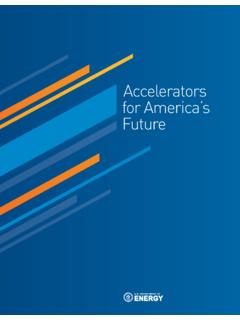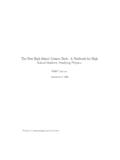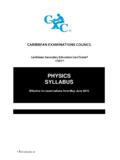Transcription of Physics 1291 General Physics I Lab - Department of Physics
1 Experiments in PhysicsPhysics 1291 General Physics I LabColumbia UniversityDepartment of PhysicsFall 2011 Contents1-0 General Instructions11-1 Uncertainty and Error71-2 Forces231-3 Velocity, Acceleration, andg351-4 Geometrical Optics I: Introduction451-5 Geometrical Optics II: Thin Lenses611-6 Geometrical Optics III: Optical Instruments731-7 Conservation of Momentum871-8 Projectile Motion and Conservation of Energy951-9 Standing Waves1031-10 Specific Heat and Mechanical Equivalent of Heat113 Introduction 1-0 General Instructions1 Purpose of the LaboratoryThe laboratory experiments described in this manual are an important part of yourphysics course. Most of the experiments are designed to illustrate important conceptsdescribed in the lectures. Whenever possible, the material will have been discussedin lecture before you come to the laboratory. But some of the material, like the firstexperiment on measurement and errors, is not discussed at length in the exceptions will be the three experiments on geometrical optics (Experiments4, 5, and 6), for which instruction will only be given in the laboratory (while youstudy mechanics in lectures).
2 This is not because the material is unimportant butbecause geometrical optics, an area of Physics permitting design of optical instruments,can be considered primarily from an experimental and practical point of view. Thefundamental nature of light, with its dual wave and particle properties (physical optics),will be treated in lecture during the second sections headed Applicationsand Lab Preparation Examples, which are in-cluded in some of the manual sections, arenotrequired reading unless your laboratoryinstructor specifically assigns some part. The Applications are intended to be moti-vational and so should indicate the importance of the laboratory material in medicaland other applications. The Lab Preparation Examples are designed to help you pre-pare for the lab; you will not be required to answer all these questions (though youshould be able to answer any of them by the end of the lab).
3 The individual laboratoryinstructors may require you to prepare answers to a subset of these Preparation for the LaboratoryIn order to keep the total time spent on laboratory work within reasonable bounds,the write-up for each experiment will be completed at the end of the lab and handedinbefore the end of each laboratory period. Therefore, it is imperativethat you spendsufficient time preparing for the experimentbeforecoming to laboratory. You shouldtake advantage of the opportunity that the experiments (except 3 and 8) are set up inthe Lab Library (Room 506)and that TAs there are willing to discuss the procedurewith you. A prior visit to the Lab Library is especially recommended for the each laboratory session, the instructor will take a few minutes at the to Each Laboratory SessionExperiment 1-0to go over the experiment to describe the equipment to be used and to outline theimportant issues.
4 This does not substitute for careful preparation beforehand! Youare expected to have studied the manual and appropriate references at home so thatyou are prepared when you arrive to perform the experiment. The instructor will beavailable primarily to answer questions, aid you in the use of the equipment, discussthe Physics behind the experiment, and guide you in completing your analysis andwrite-up. Your instructor will describe his/her policy regarding expectations duringthe first lab experiments and write-ups may be completed in less than the three-hourlaboratory period, but under no circumstances will you be permitted to stay in the labafter the end of the period or to take your report home to complete it. If it appearsthat you will be unable to complete all parts of the experiment, the instructor willarrange with you to limit the experimental work so that you have enough time to writethe report during the lab : Laboratory equipment must be handled with care and each laboratory benchmust be returned to a neat and orderly state before you leave the laboratory.
5 Inparticular, you must turn off all sources of electricity, water, and Bring to Each Laboratory Session A pocket calculator (with basic arithmetic and trigonometric operations). A pad of 11 inch graph paper and a sharp pencil. (You will write your reportson this paper, including your graphs. Covers and staplers will be provided in thelaboratory.) A ruler (at least 10 cm long).4 Graph PlottingFrequently, a graph is the clearest way to represent the relationship between the quan-tities of interest. There are a number of conventions, which we include below. A graph indicates a relation between two quantities,xandy, when other variablesor parameters have fixed values. Before plotting points on a graph, it may beuseful to arrange the corresponding values ofxandyin a table. Choose a convenient scale for each axis so that the plotted points will occupy asubstantialpart of the graph paper, but do notchoose a scale which is difficult2 Experiment 1-0 General Instructionsto plot and read, such as 3 or 3/4 units to a square.
6 Graphs should usually beat least half a page in size. Label each axis to identify the variable being plotted and the units being prominent divisions on each axis with appropriate numbers. Identify plottedpointswith appropriate symbols, such as crosses, and when nec-essary draw vertical or horizontalbarsthrough the points to indicate the rangeof uncertainty involved in these points. Often there will be a theory concerning the relationship of the two plotted vari-ables. A linear relationship can be demonstrated if the data points fall along asingle straight line. There are mathematical techniques for determining whichstraight line best fits the data, but for the purposes of this lab it will be sufficientif you simply make a rough estimate straight line should be drawnas near the mean of the all various points as is optimal. That is, the line neednot precisely pass through the first and last points.
7 Instead, each point should beconsidered as accurate as any other point (unless there are experimental reasonswhy some points are less accurate than others). The line should be drawn withabout as many points above it as below it, and with the aboves and belows distributed at random along the line. (For example, not all points should beabove the line at one end and below at the other end).5 Error AnalysisAll measurements, however carefully made, give a range of possible values referred to asan uncertainty or error. Since all of science depends on measurements, it is importantto understand uncertainties and where they come from. Error analysis is the set oftechniques for dealing with science, the word error does not take the usual meaning of mistake . Instead,we will use it interchangeably with uncertainty when talking about the result of ameasurement. There are many aspects to error analysis and it will feature in someform in every lab throughout this Inevitability of Experimental ErrorIn the first experiment of the semester, you will measure the length of a a ruler, you might compare it to your own height and (after converting tometers) make an estimate of m.
8 Of course, this is only approximate. To quantifythis, you might say that you are sure it is not less than m and not more than a ruler, you measure m. This is a much better estimate, but there is AnalysisExperiment 1-0uncertainty. You couldn t possibly say that the pendulum isn t m long. If youbecame obsessed with finding the exact length of the pendulum you could buy a fancydevice using a laser, but even this will have an error associated with the wavelength , at this point you would come up against another problem. You would findthat the string is slightly stretched when the weight is on it and the length even dependson the temperature or moisture in the room. So which length do you use? This is aproblem of definition. During lab you might find another example. You might askwhether to measure from the bottom, top or middle of the weight. Sometimes one ofthe choices is preferable for some reason (in this case the middle because it is the centerof mass).
9 However, in General it is more important to be clear about what you mean by the length of the pendulum and consistent when taking more than one that the different lengths that you measure from the top, bottom or middle ofthe weight do not contribute to the to the range of values given bymeasurements of exactly the same Importance of ErrorsIn daily life, we usually deal with errors intuitively. If someone says I ll meet you at9:00 , there is an understanding of what range of times is OK. However, if you want toknow how long it takes to get to JFK airport by train you might need to think aboutthe range of possible values. You might say It ll probably take an hour and a half,but I ll allow two hours . Usually it will take within about 10 minutes of this mostprobable time. Sometimes it will take a little less than 1hr20, sometimes a little morethan 1hr40, but by allowing the most probable time plus three times this uncertaintyof 10 minutes you are almost certain to make it.
10 In more technical applications, forexample air traffic control, more careful consideration of such uncertainties is science, almost every time that a new theory overthrows an old one, a discussionor debate about relevant errors takes place. In this course, we will definitely not be ableto overthrow established theories. Instead, we will verify them with the best accuracyallowed by our equipment. The first experiment involves measuring the gravitationalacceleration g. While this fundamental parameter has clearly been measured with muchgreater accuracy elsewhere, the goal is to make the most accurate possible verificationusing very simple apparatus which can be a genuinely interesting are several techniques that we will use to deal with errors throughout thecourse. All of them are well explained, with more formal justifications, in An Intro-duction to Error Analysis by John Taylor, available in the Science and EngineeringLibrary in the Northwest Corner 1-0 General Questions or ComplaintsIf you have a difficulty, you should attempt to work it through with your laboratoryinstructor.







